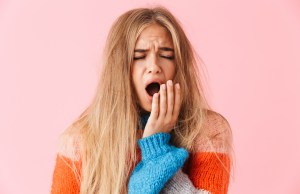Like a cold blast of air, seasonal affective disorder (also known as seasonal depression) hits hard for those who experience it. There’s more to this emotional disorder than just feeling down in the winter, though.
We’re here to help you navigate the ins and outs of seasonal depression, and find actual answers to the questions you have about it. From understanding your risk factors to identifying treatment options, we’ve assembled our knowledge into this comprehensive guide. Read it in full or easily jump between sections to focus on the information you’re looking for.

What Is Seasonal Depression?
Seasonal depression, also known as seasonal affective disorder (SAD), is a type of depression that occurs during seasonal shifts. People with SAD are primarily affected at the start of the fall and winter months when weather conditions reduce the amount of sunlight and time we spend outdoors.
What Causes Seasonal Depression?
Research supports that seasonal affective disorder is linked to a chemical imbalance in the brain, which may be caused by a lack of sunlight and reduced physical activity. Still, seasonal affective disorder is a complex mental health condition, and like with many others, the biological mechanisms at play are still largely unknown.
Hello, we're here to help you
We provide award-winning mental health services nationwide, with flexible scheduling & insurance coverage. Start your journey this week.
Who Is at Risk of Developing Seasonal Depression?
Those in northern states and colder, temperate climates are at higher risk of developing seasonal depression, where less sunlight and time spent outside takes a toll. People who are less active, suffer from mobility issues, or spend a lot of time indoors are also more susceptible. Additionally, you may be at an increased risk if:
- You have a relative with seasonal depression: Emotional disorders, including the different forms of depression, can be highly heritable. If a parent or sibling is struggling or has struggled with seasonal depression, it’s important to evaluate your own risk through preventative mental health care.
- You’re a woman: A 2018 study found that women are more likely than men to develop depressive symptoms during the fall and winter months. The reasons aren’t necessarily clear but may be related to biological risks including menopause and pregnancy-related conditions like postpartum depression that might affect mood.
- You have another, pre-existing mental health condition—especially if it’s an anxiety disorder: Anxiety and depression like to feed off of one another, as clinical research has established. If you have one, it’s possible that you may develop the other; take caution if you’re already coping with an anxiety disorder.
Additionally, you’re at increased risk of developing seasonal affective disorder if you are between the ages of 18 and 30 and live in a northern climate.
What Are the Symptoms of Seasonal Depression?
The symptoms of seasonal affective disorder include but aren’t limited to:
- Lack of interest in hobbies, sex, friendships, and daily life
- Being distant, withdrawn, or moody
- Despondent attitude towards life
- Reduced appetite
- Inability to concentrate
- Thoughts of self-harm or suicide
- Outbursts of anger or overwhelming sadness
Like other types of depression, seasonal affective disorder can affect everyone differently. Although all seasonal affective disorder cases are related to seasonal changes, the symptoms you experience could be highly subjective, which is completely okay; talking with a mental health professional about your symptoms is a critical part of receiving mental health treatment (more on this later).
What Are the Diagnostic Criteria for Seasonal Affective Disorder?
The diagnostic criteria for seasonal affective disorder can be divided into several categories for ease of understanding. First, you must meet the diagnostic criteria for major depression, which means exhibiting at least five of the following symptoms and at least one of the first two listed:
- Depressed mood
- Others notice a change in your behavior
- Loss of interest in day-to-day activities
- Marked changes in weight or appetite
- Sleep disruptions, trouble falling asleep or waking up
- Fatigue
- Difficulty concentrating
- Feelings of worthlessness
- Thoughts about death or suicidal ideation
Then, you must also: 1) Shed the above symptoms at the end of the season. For example, your depressed mood and loss of interest dissipate with the arrival of spring. 2) Experience this seasonal depressive pattern for two years or more. 3) If you experience depressive episodes outside of the seasonal bouts, there must be a significantly lower amount.
How Common Is Seasonal Depression?
Five percent of the U.S population suffers from seasonal affective disorder each year, which is equivalent to more than 17 million people. seasonal affective disorder cases are more common and numerous in northern states than they are in southern areas.
When Does Seasonal Affective Disorder Start?
The onset of seasonal affective disorder varies, but generally, most people will start experiencing their depressive symptoms in mid-to-late fall, with January and February typically being the worst months. Waning amounts of sunlight and dropping temperatures subtly influence our bodies and mood, even in people without seasonal depression. Changes in the amount of sunlight during the day can also negatively affect our circadian rhythms, disrupting our sleep patterns and making us more susceptible to mental health conditions.
Can People Get Seasonal Affective Disorder in the Summer?
Yes, it’s possible to suffer from seasonal affective disorder throughout the summer months. Summer-onset seasonal affective disorder is actually thought to be caused by too much sun, which may cause emotional irritation as the body attempts to regulate its inflammation levels and temperature. The relationship between our mental health and our environment is complex—and sunlight levels at all times of the year can drastically affect some people’s mental health.
To cope with summer-onset seasonal depression, which often causes light sensitivity, draw the blinds or curtains throughout the day if the summer sun is too much. And if the heat is causing you to become restless, turn up the A/C. Lowering the temperature in your house or apartment may help you relax.
How Long Does Seasonal Affective Disorder Last?
Seasonal affective disorder symptoms typically last for 4-5 months or about 40% of the year. Symptoms usually start to ease off in mid-spring as temperatures increase and being outside and physically active is more enjoyable. Like many other mental health conditions, seasonal affective disorder may last shorter or longer based on your own circumstances and treatment methods.
Can Seasonal Affective Disorder Cause Anxiety?
Possibly. The link between anxiety and depression is complicated, to say the least. But so far, researchers theorize that different forms of depression and anxiety may have a causal relationship. This could mean that if you have anxiety or seasonal depression, you may be more likely to also develop the other condition, as a result.
Having one or more mental health conditions isn’t unusual in the slightest—remember that you aren’t alone and don’t hesitate to seek help if you’re feeling anxious and/or depressed.
How Is Seasonal Affective Disorder Treated?
Treatment for seasonal affective disorder depends on the severity of your depression, as well as your own preferences. Generally, though, those with seasonal affective disorder often benefit from:
- Cognitive behavioral therapy (CBT): CBT is a great treatment for mild to moderate cases of depression. CBT methods will allow your therapist to help you identify and correct the negative thoughts that may be causing your emotional distress. You’ll also learn to replace harmful thoughts with productive ones and implement coping methods to use in real-life scenarios.
- Light therapy: Those with seasonal affective disorder can also use light therapy boxes, which give off natural light. Light boxes can help to alleviate symptoms and reduce the severity of depression during the fall and winter months.
- Prescription medication: Medication is often beneficial for more severe or persistent cases of seasonal depression. With medication from a psychiatrist, those with seasonal affective disorder can get the extra help they need to counteract the condition’s harmful physical and emotional effects.
- Self-care: Prioritizing your needs in order to preserve your mental health is what self-care is all about. For seasonal affective disorder sufferers, physical exercise, most notably outdoor activities, like taking walks, is a way to increase sunlight exposure and boost your mood and energy levels. If you’re interested in learning more about self-care routines, a therapist can also offer tips and recommendations based on your symptoms and experience with seasonal depression.
Can I Prevent Seasonal Depression?
There’s no way to completely prevent seasonal depression, but there are definitely ways to reduce our risk of developing it. Try:
- Proactively attending therapy: A therapist who specializes in CBT methods can help to identify and manage harmful thoughts and behaviors when they happen. Even if you aren’t currently struggling with seasonal depression, you may be able to spot the signs of it if you start to develop them.
- Going for a walk, a run, or a bike ride: Spending time outdoors when possible is often recommended for seasonal affective disorder sufferers to increase their sun exposure and normal hormone production.
- Considering a vitamin D supplement: Low vitamin D levels are attributed to lack of sunlight exposure and have been associated with an increased risk of seasonal depression.
- Opening up to loved ones: Talk about your symptoms with family and friends who may be able to help support you and watch out for concerning changes in your behavior or mood.
How Can I Best Combat Seasonal Depression?
The best way to combat seasonal affective disorder is to seek out mental health services. If you’re experiencing depressive symptoms you may already be feeling isolated, so trying to fight seasonal affective disorder on your own could make matters worse. Attending counseling or therapy could help you better manage the symptoms of your seasonal depression; and for more severe cases, prescription medication from a psychiatrist may be more effective.
You can even consider attending mental health services during spring and summer when you’re feeling your best. Therapy year-round could better prepare you to work through your depressive symptoms when they’re present.













